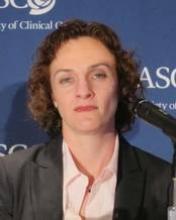CHICAGO – Breast cancer risk is much higher than previously recognized among women who received chest radiation for Hodgkin’s lymphoma when they were children, investigators reported.
By the time these survivors are 50 years of age, breast cancer incidence is 30% – "remarkably similar" to the 31% incidence observed in the high-risk group of women with BRCA1 mutations, Chaya S. Moskowitz, Ph.D., and her colleagues determined in a study presented at the annual meeting of the American Society of Clinical Oncology.
Although the effect was less dramatic, cumulative risk also was elevated in survivors of other childhood cancers treated with chest radiation, reaching 24% overall by age 50, Dr. Moskowitz said at a press briefing. Among the general population of women in the United States, it is 4% at that benchmark, she noted.
Particularly concerning is the heightened risk observed in women who received less radiation than the current threshold at which the Children’s Oncology Group (COG) recommends breast cancer surveillance. The COG says that survivors who received 20 Gy or more of chest radiation should start annual mammograms at age 25 years or 8 years after radiotherapy, whichever comes later.
In this group, 12% of survivors will develop breast cancer by age 40, said Dr. Moskowitz, a biostatistician at Memorial Sloan-Kettering Cancer Center in New York. The study showed that breast cancer incidence also was elevated, albeit not as dramatically – 7% by age 40 – among survivors who received 10-19 Gy of radiation.
Excess risk in those treated with 10-19 Gy warrants "consideration of breast cancer surveillance strategies similar to the current recommendations for women treated with [more than] 20 Gy," the investigators concluded.
About 50,000 survivors received 20 Gy or more of radiation and, therefore, meet the current threshold, Dr. Moskowitz said. Lowering the threshold to include survivors who were treated with 10-19 Gy of chest radiation would add another 7,000-9,000 women.
Increasing public awareness is crucial to increasing surveillance. "Many women who were treated with chest radiation don’t know they have an increased risk of breast cancer," she said. "Their physicians may or may not know, but many physicians are not aware of the guidelines."
Moreover, many survivors don’t know their radiation exposure, and she urged them to try to find those records from long, long ago.
The analysis – a report from the Childhood Cancer Survivor Study (CCSS) and the Women’s Environmental Cancer and Radiation Epidemiology (WECARE) study – mined data on 1,268 women survivors of childhood cancers diagnosed from 1970 to 1986 and on 4,570 first-degree relatives of women who had survived at least 1 year after being diagnosed with breast cancer.
Median follow-up was 26 years in the childhood survivors, of whom 175 women were diagnosed with breast cancer as adults. Median latency was 23 years after treatment, and diagnosis was made at a median age of 38 years.
Multiple studies have shown an increased risk of breast cancer in women who received chest radiation as children, Dr. Moskowitz said. This large study has substantially longer follow-up and was surprising in the magnitude of risk it documents.
Chest radiation doses are lower today, and mantle field radiation – which had been used almost exclusively in Hodgkin’s lymphoma – is no longer used, but other regimens are still in the clinic, she added.
Another surprise from the study was that whole lung radiation, even at low doses, can heighten breast cancer risk. "Women treated with whole lung radiation have a risk of breast cancer that is higher than previous recognized and may benefit from surveillance strategies," she said.
"These are striking data and certainly warrant our careful attention," commented press briefing chair Dr. Nicholas Vogelzang, chair and medical director of the developmental therapeutics committee at the Comprehensive Cancer Centers of Nevada, Las Vegas, and cochair of the genitourinary committee for U.S. Oncology Research.
"The benefit of curing a cancer is you can live 25 or more years," he said, noting that curves for breast cancer incidence rose after 25 years in a graphic representation of the data presented. "We have an obligation to those many thousands of young women whom we treated many years ago."
The investigators said that they had no relevant financial disclosures.


